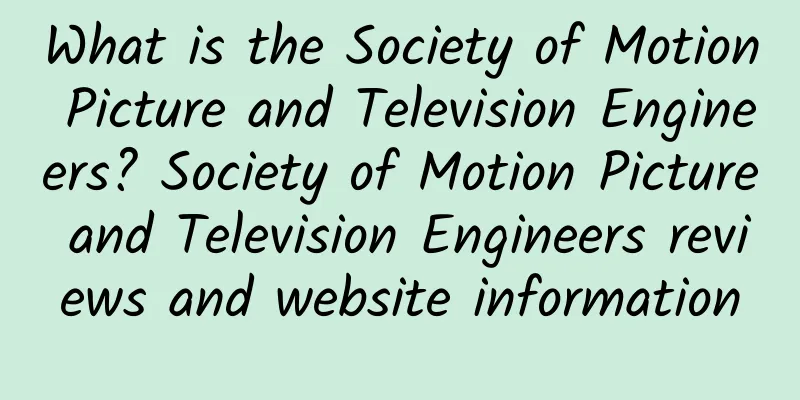What is the Society of Motion Picture and Television Engineers? Society of Motion Picture and Television Engineers reviews and website information

|
What is the website of the Society of Motion Picture and Television Engineers? The Society of Motion Picture and Television Engineers (SMPTE) is an American organization founded in 1916 and headquartered in New York. It has formulated many film and television industry standards. Website: www.smpte.org The Society of Motion Picture and Television Engineers (SMPTE) is an international professional organization with significant influence in the film and television industry. Since its establishment in 1916, SMPTE has been committed to promoting scientific and technological progress in film, television and related fields, formulating and promoting industry standards, and promoting the healthy development of the global film and television industry. As an authoritative organization in the field of global film and television technology, SMPTE enjoys a very high reputation in the industry, and its standards are widely used in many fields such as film production, television broadcasting, and streaming services. 1. Background and History of SMPTEThe establishment of SMPTE can be traced back to the early 20th century, when the film industry was in a rapid development stage, but lacked unified technical standards and specifications. In 1916, a group of engineers and technical experts from the American film industry decided to establish an organization to solve common problems in the field of film technology and promote the standardization process of the industry. As a result, SMPTE came into being and became the world's first professional association focusing on film and television technology. In its early days, SMPTE's main task was to develop standards for motion picture films, including film size, projection speed, sound synchronization, etc. With the rise of television technology, SMPTE gradually expanded its business scope to the television field and became one of the main setters of television technology standards in the mid-20th century. Today, SMPTE not only covers traditional film and television technologies, but also actively involves in emerging fields such as digital media, streaming media, virtual reality (VR), and augmented reality (AR). 2. SMPTE's Mission and VisionSMPTE's mission is to promote the sustainable development of the global film and television industry by developing and promoting industry standards, promoting technological innovation in film, television and related fields. Its vision is to become a leader in the field of global film and television technology and provide authoritative technical support and professional services to the industry. In order to achieve this mission and vision, SMPTE has carried out a series of activities, including technical research, standard setting, education and training, industry exchanges, etc. Through these activities, SMPTE not only provides important technical support for the industry, but also provides a communication and cooperation platform for practitioners, promoting the advancement of global film and television technology. 3. SMPTE’s main business areas1. Standard settingStandard setting is one of SMPTE's core businesses. Since its establishment, SMPTE has developed hundreds of industry standards covering a wide range of fields, including film, television, digital media, etc. These standards not only provide unified technical specifications for the industry, but also promote compatibility and interoperability between different technologies. For example, the film standards developed by SMPTE (such as 35mm and 70mm film standards) are widely adopted around the world and have become the basis for film production and projection. In the field of television, the high-definition television (HDTV) standards developed by SMPTE have laid the foundation for the popularization of HDTV. In addition, SMPTE has also developed many standards related to digital media, such as digital cinema packaging (DCP) and streaming media transmission protocols, providing technical support for the development of digital media. 2. Technical researchSMPTE not only sets standards, but also actively conducts technical research to promote technological innovation in the industry. SMPTE has several technical committees responsible for researching cutting-edge technologies in film, television and related fields. These committees are composed of industry experts and hold regular meetings to discuss technology development trends and develop corresponding technical specifications and standards. In recent years, SMPTE's technical research has focused on emerging fields such as digital media, virtual reality, augmented reality, and artificial intelligence. For example, SMPTE is studying how to apply artificial intelligence technology to film production and television broadcasting to improve production efficiency and content quality. In addition, SMPTE is also exploring the application of virtual reality and augmented reality technology in film and television production to provide the industry with new creative tools and technical support. 3. Education and trainingSMPTE attaches great importance to education and training, and is committed to cultivating high-quality technical talents for the industry. SMPTE holds a number of technical seminars, training courses and certification exams every year to provide practitioners with professional technical training and learning opportunities. For example, SMPTE's Advanced Technology Seminars attract thousands of technical experts and practitioners from around the world, becoming the industry's top technology exchange platform. In addition, SMPTE has launched a number of certification programs, such as SMPTE Certified Engineer, to provide practitioners with authoritative professional qualification certification. 4. Industry ExchangeSMPTE provides a broad communication platform for industry practitioners to promote technical cooperation and knowledge sharing. SMPTE regularly holds international conferences, exhibitions and technical forums, inviting the world's top technical experts and corporate representatives to participate and discuss industry development trends and technological innovations. For example, the SMPTE Annual Technical Conference & Exhibition is the top event in the field of global film and television technology, attracting thousands of participants from all over the world. In addition, SMPTE also has several regional chapters that regularly hold localized technical exchange activities to provide practitioners with more learning and cooperation opportunities. 4. SMPTE’s Global InfluenceAs an authoritative organization in the field of global film and television technology, SMPTE has influence all over the world. SMPTE members come from more than 100 countries around the world, covering practitioners in multiple fields such as film, television, digital media, and streaming media. SMPTE standards are widely used in the global film and television industry and have become technical specifications in the industry. For example, the Digital Cinema Package (DCP) standard developed by SMPTE has been adopted by major film studios and cinemas around the world, becoming the basis for the distribution and screening of digital films. In addition, SMPTE's High Definition Television (HDTV) standard provides technical support for the popularization of HDTV around the world and promotes the technological upgrading of the television industry. In China, SMPTE's influence is also expanding. In recent years, SMPTE has carried out a number of cooperation with China's radio and television industry to promote the development of China's film and television technology. For example, SMPTE cooperated with the State Administration of Radio, Film and Television of China to jointly develop a number of digital television standards, providing technical support for the popularization of digital television in China. In addition, SMPTE has also cooperated with Chinese universities and research institutions to carry out a number of technical research and education and training projects, cultivating a large number of high-quality technical talents for China's film and television industry. 5. SMPTE’s future development directionWith the continuous advancement of science and technology, the film and television industry is facing unprecedented opportunities and challenges. As a technical leader in the industry, SMPTE will continue to be committed to promoting technological innovation and standardization in the industry and providing technical support for the development of the global film and television industry. In the future, SMPTE will focus on the following areas: 1. Digital Media and StreamingWith the rapid development of digital media and streaming media technology, the production and dissemination of film and television content is undergoing profound changes. SMPTE will continue to develop standards related to digital media and streaming media to promote technological upgrades in the industry. For example, SMPTE is studying how to improve the efficiency and stability of streaming media transmission to meet the growing demand for streaming media. 2. Virtual Reality and Augmented RealityVirtual reality (VR) and augmented reality (AR) technologies provide new possibilities for film and television creation. SMPTE will actively explore the application of these new technologies in film and television production, formulate corresponding technical standards and specifications, and provide new creative tools and technical support for the industry. 3. Artificial IntelligenceArtificial intelligence (AI) technology is playing an increasingly important role in the film and television industry. SMPTE will study how to apply AI technology to film production, television broadcasting and digital media to improve production efficiency and content quality. For example, SMPTE is exploring how to use AI technology for automatic editing, special effects generation and content recommendation. 4. Sustainable developmentAs the world pays more attention to sustainable development, the film and television industry also needs to explore more environmentally friendly production and dissemination methods. SMPTE will be committed to promoting the industry's transformation towards sustainable development, formulating technical standards and specifications related to environmental protection, and providing technical support for the sustainable development of the industry. 6. How to join SMPTEFor professionals working in film, television, digital media and other related fields, joining SMPTE is an excellent opportunity to improve their technical level and expand their industry contacts. SMPTE provides members with a variety of services, including technical training, certification exams, industry exchanges, etc., to help members achieve greater success in their careers. To join SMPTE, you can apply online through its official website (www.smpte.org). SMPTE members are divided into two types: individual members and corporate members. Individual members include ordinary members, student members and lifetime members, while corporate members include corporate members and sponsoring members. Different types of members enjoy different rights and services. Specific information can be found on the SMPTE official website. 7. SMPTE’s Success StoriesOver the past 100 years, SMPTE has made many important achievements in film, television and related fields. The following are some of SMPTE's success stories: 1. Development of film standardsThe 35mm and 70mm film standards developed by SMPTE in the early 20th century provided uniform technical specifications for film production and projection, and promoted the development of the global film industry. These standards are still widely used in film production today. 2. Development of HDTV standardsThe high-definition television (HDTV) standard established by SMPTE at the end of the 20th century provided technical support for the popularization of HDTV and promoted the technological upgrading of the television industry. Today, HDTV has become the mainstream format for television broadcasting around the world. 3. Development of Digital Cinema Package (DCP) StandardsThe Digital Cinema Package (DCP) standard developed by SMPTE provides unified technical specifications for the distribution and screening of digital films, promoting the popularity of digital films around the world. Today, DCP has become the standard format for the distribution and screening of digital films. 4. Development of streaming media transmission protocolWith the rapid development of streaming media technology, SMPTE has formulated a series of standards related to streaming media transmission, which has improved the efficiency and stability of streaming media transmission and provided technical support for the development of the global streaming media industry. 8. Relationship between SMPTE and other industry organizationsSMPTE maintains close cooperation with other industry organizations to jointly promote the development of global film and television technology. For example, SMPTE cooperates with international organizations such as the International Telecommunication Union (ITU), the International Organization for Standardization (ISO), and the International Electrotechnical Commission (IEC) to jointly develop international standards related to film and television technology. In addition, SMPTE has established cooperative relations with radio and television organizations, film associations, and technical research institutions in many countries and regions, promoting the exchange and cooperation of global film and television technology. For example, SMPTE has cooperated with organizations such as the State Administration of Radio and Television of China, the European Broadcasting Union (EBU), and the Motion Picture Association of America (MPAA) to jointly carry out a number of technical research and standard setting work. IX. SMPTE Publications and ResourcesSMPTE provides members and industry practitioners with a wealth of publications and resources to help them understand industry dynamics and technology trends. For example, SMPTE's official journal, SMPTE Motion Imaging Journal, is one of the most influential technical journals in the industry, regularly publishing research papers and technical articles related to film, television and related fields. In addition, SMPTE has published a number of technical manuals and standard documents to provide detailed technical references for practitioners. These publications and resources not only provide important technical support for practitioners, but also provide a theoretical basis for technological innovation in the industry. 10. SMPTE’s Future OutlookWith the continuous advancement of science and technology, the film and television industry is facing unprecedented opportunities and challenges. SMPTE will continue to promote technological innovation and standardization in the industry and provide technical support for the development of the global film and television industry. In the future, SMPTE will focus on emerging fields such as digital media, virtual reality, augmented reality, and artificial intelligence, formulate corresponding technical standards and specifications, and provide new creative tools and technical support for the industry. In addition, SMPTE will also actively explore technical paths for sustainable development and promote the transformation of the industry towards a more environmentally friendly direction. In short, as a leader in the field of global film and television technology, SMPTE will continue to provide authoritative technical support and professional services to the industry, and promote the sustainable development and prosperity of the global film and television industry. |
<<: How is the Axis Powers History Forum? Axis Powers History Forum Review and Website Information
>>: What is Union Carbide like? Union Carbide reviews and website information
Recommend
How is Aomori Prefectural Health University? Aomori Prefectural Health University reviews and website information
What is the website of Aomori University of Health...
The magical effects of wild blueberries
How many of you know about the magical effects of...
Sharif Football Club review and website information
What is the website of Sheriff Football Club? Sher...
How is Miami University Oxford? Miami University Oxford reviews and website information
What is the website of Miami University Oxford? Mi...
Spiced melon seeds
I believe everyone is familiar with five-spice me...
What are the wonderful uses of baking soda?
Baking soda is very common in our daily life. It ...
How is Men's Goods? Men's Goods Reviews and Website Information
What is Menstuff? Menstuff is a well-known male re...
The efficacy and nutritional value of wintersweet flowers
I once visited Lu Xun's former residence in w...
Nutritional value and medicinal value of wild leek
Wild leek, also known as mountain leek, is a wild...
How to pickle peppers
Chili is a condiment. Usually, the chili fruits c...
How to make Hosta porridge
Do you still remember how to make Hosta porridge?...
The nutritional value and eating methods of wild rice stem
Wild rice is a delicious daily dish. We usually c...
How to cook ten-grain rice and make it delicious? The correct way to cook ten-grain rice
Ten-grain rice is particularly suitable for cooki...
Fragrant Laba Porridge
The fragrant Laba porridge tastes very fragrant. ...
The efficacy and function of Hosta
The hosta flower is a plant that can be used as m...









